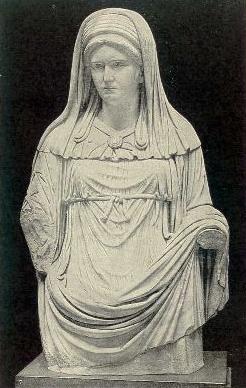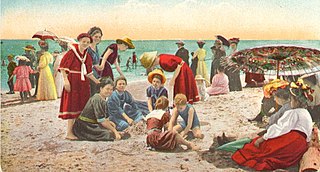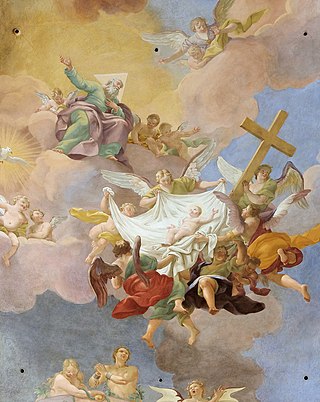
The First Epistle to the Corinthians is one of the Pauline epistles, part of the New Testament of the Christian Bible. The epistle is attributed to Paul the Apostle and a co-author, Sosthenes, and is addressed to the Christian church in Corinth. Despite the name, it is not believed to be the first such letter. Scholars believe that Sosthenes was the amanuensis who wrote down the text of the letter at Paul's direction. It addresses various issues that had arisen in the Christian community at Corinth and is composed in a form of Koine Greek.

A veil is an article of clothing or hanging cloth that is intended to cover some part of the head or face, or an object of some significance. Veiling has a long history in European, Asian, and African societies. The practice has been prominent in different forms in Judaism, Christianity, and Islam. The practice of veiling is especially associated with women and sacred objects, though in some cultures, it is men, rather than women, who are expected to wear a veil. Besides its enduring religious significance, veiling continues to play a role in some modern secular contexts, such as wedding customs.

Modesty, sometimes known as demureness, is a mode of dress and deportment which intends to avoid the encouraging of sexual attraction in others. The word modesty comes from the Latin word modestus which means 'keeping within measure'.

In Christian theology, "legalism" is a pejorative term applied to the idea that "by doing good works or by obeying the law, a person earns and merits salvation."
The Church of God in Christ, Mennonite, also called Holdeman Mennonite, is a Christian Church of Anabaptist heritage. Its formation started in 1859 under its first leader, a self-described prophet named John Holdeman (1832-1900), who was a baptized Mennonite. The Church of God in Christ, Mennonite is Conservative Mennonite that has distanced itself from other Conservative Mennonites because of its one true church doctrine. In 2013 the church had 24,400 baptized members.

Anabaptist theology, also known as Anabaptist doctrine, is a theological tradition reflecting the doctrine of the Anabaptist Churches. The major branches of Anabaptist Christianity agree on core doctrines but have nuances in practice. While the adherence to doctrine is important in Anabaptist Christianity, living righteously is stressed to a greater degree.

Covenant theology is a conceptual overview and interpretive framework for understanding the overall structure of the Bible. It uses the theological concept of a covenant as an organizing principle for Christian theology. The standard form of covenant theology views the history of God's dealings with mankind, from Creation to Fall to Redemption to Consummation, under the framework of three overarching theological covenants: those of redemption, of works, and of grace.

A headscarf is a scarf covering most or all of the top of a person's, usually women's, hair and head, leaving the face uncovered. A headscarf is formed of a triangular cloth or a square cloth folded into a triangle, with which the head is covered.

A mantilla is a traditional female liturgical lace or silk veil or shawl worn over the head and shoulders, often over a high hair ornament called a peineta, particularly popular with women in Spain and Latin America. It is also worn by Catholic and Plymouth Brethren women around the world, Mennonite women in Argentina, and without the peineta by Eastern Orthodox women in Russia. When worn by Eastern Orthodox women the mantilla is often white, and is worn with the ends crossed over the neck and draped over the opposite shoulder. The mantilla is worn as a Christian headcovering by women during church services, as well as during special occasions. A smaller version of the mantilla is called a toquilla.
Outward holiness, or external holiness, is a Wesleyan–Arminian doctrine emphasizing modest dress and sober speech. It is a testimony of a Christian believer's regeneration, done in obedience to God. The doctrine is prevalent among denominations emerging during the revival movements, including the Methodists, as well as Pentecostals. It is taken from 1 Peter 1:15: "He which hath called you is Holy, so be ye holy in all manner of conversation."

Christian head covering, also known as Christian veiling, is the traditional practice of women covering their head in a variety of Christian denominations. Some Christian women wear the head covering in public worship and during private prayer at home, while others believe women should wear head coverings at all times. Among Oriental and Eastern Orthodox Churches, certain theologians likewise teach that it is "expected of all women to be covered not only during liturgical periods of prayer, but at all times, for this was their honor and sign of authority given by our Lord", while others have held that headcovering should at least be done during prayer and worship. Genesis 24:65 records the veil as a feminine emblem of modesty. Manuals of early Christianity, including the Didascalia Apostolorum and Pædagogus, instructed that a headcovering must be worn by women during prayer and worship as well as when outside the home. When Saint Paul commanded women to be veiled in 1 Corinthians, the surrounding pagan Greek women did not wear headcoverings; as such, the practice of Christian headcovering was countercultural in the Apostolic Era, being a biblical ordinance rather than a cultural tradition. The style of headcovering varies by region, though Apostolic Tradition specifies an "opaque cloth, not with a veil of thin linen".
Many Christians have followed certain dress codes during attendance at church. Customs have varied over time and among different Christian denominations. As with the Bible, the Church Fathers of Christianity taught modesty as a core principle guiding the clothing that Christians are to manufacture and wear.

The roles of women in Christianity have varied since its founding. Women have played important roles in Christianity especially in marriage and in formal ministry positions within certain Christian denominations, and parachurch organizations. In 2016, it was estimated that 52–53 percent of the world's Christian population aged 20 years and over was female, with this figure falling to 51.6 percent in 2020. The Pew Research Center studied the effects of gender on religiosity throughout the world, finding that Christian women in 53 countries are generally more religious than Christian men, while Christians of both genders in African countries are equally likely to regularly attend services.

An ordinance is a term used by certain Christian denominations for a religious ritual that was instituted by Jesus for Christians to observe.

Plain dress is a practice among some religious groups, primarily some Christian churches in which people dress in clothes of traditional modest design, sturdy fabric, and conservative cut. It is intended to show acceptance of traditional gender roles, modesty, and readiness to work and serve, and to preserve communal identity and separation from the immodest, ever-changing fashions of the world. For men, this often takes the form of trousers secured by suspenders, while for women, plain dress usually takes the form of a cape dress along with a headcovering.
Conservative Mennonites include numerous Conservative Anabaptist groups that identify with the theologically conservative element among Mennonite Anabaptist Christian fellowships, but who are not Old Order groups or mainline denominations.

Headgear, headwear, or headdress is any element of clothing which is worn on one's head, including hats, helmets, turbans and many other types. Headgear is worn for many purposes, including protection against the elements, decoration, or for religious or cultural reasons, including social conventions.

The Last Adam, also given as the Final Adam or the UltimateAdam, is a title given to Jesus in the New Testament. Similar titles that also refer to Jesus include Second Adam and New Adam.

A kapp is a Christian headcovering worn by many women of certain Anabaptist Christian denominations, as well as certain Conservative Friends and Plain Catholics, in obedience to Paul the Apostle's command in 1 Corinthians 11:2–10.

A hanging veil, also known as a flowing veil or charity veil, is a type of Christian headcovering, which is worn by some Christian women continually, in obedience to Paul the Apostle's command in 1 Corinthians 11:2–10. Hanging veils enjoy popularity in a diverse array of Christian denominations, especially those of the Anabaptist Christian tradition. In certain Conservative Mennonite Anabaptist congregationations of the Beachy Amish Mennonite tradition, an opaque hanging veil is permitted as an alternative to the kapp if it covers as much or more hair as the kapp, which traditionally is "of ample size to cover most of the hair". Opaque hanging veils are usually white or black in colour for modesty. Hanging veils are designed to drape over the natural curves of a woman's head and hang down a woman's neck. Certain denominations of Christianity provide guidelines regarding the headcovering; the Ministry Training Center of the Biblical Mennonite Alliance, for example, teaches:
A veiling shall be worn by the sisters. We believe the best application of the headship principle as taught in I Corinthians 11 is for the veiling to be worn as a part of their regular attire to cover hair that is allowed to grow to its natural length. Ladies shall wear all their hair neatly up, avoiding fashion extremes, covered with a hanging veil, scarf, or traditional Mennonite covering of sufficient size to substantially cover the hair. Hanging veils and scarves must cover at least from the crown of the head to the bottom of the hair bun.
















